 Phase 1 - The preparations before the Battle
Phase 1 - The preparations before the Battle
The Great War in 1914 and 1915
The Great War, or as we now call it - the First World War, began on 4 August 1914. By the end of that year all movement of the armies had ceased and the war had become an immobile trench war. In 1915 several attempts were made to forcibly achieve a decisive
breakthrough. However, these attempts all failed and only lead to terrible
losses. Both parties were convinced that 1916 would be the year of their crucial
victory. Germany expected to have this at Verdun. The allies tried to realise their victory through a joint operation at the river Somme.
 Click here to see the map
of the Battle of Verdun 1916
Click here to see the map
of the Battle of Verdun 1916
The German plan of attack
The German commander-in-chief General Erich von Falkenhayn considered England to be
Germany’s most important enemy. He believed England would collapse as soon as France, their most important ally, would be defeated.
That is why a target had to be found that would be so important to the
French, that they would be willing to sacrifice their entire army. This army
would 'bleed to death' (the Germans called this 'weissbluten') and
could then easily be defeated. Geographically this had to be Verdun. Of old,
Verdun was an important stronghold at the Eastern border. Firstly, because
it played an important part in the line of defence, which was built after
the French - Prussian war of 1870. Secondly, it was the Northern gate to the
Champagne plain and therefore Paris. Another reason was that Verdun had been
able to withstand the German attacks of 1914. It was an important garrison
and had a fortified citadel.
|
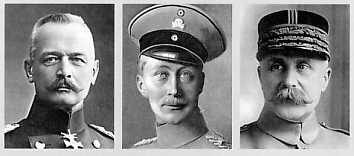
|
Three main characters in the battle of Verdun:
from left to right: Von Falkenhayn, the Crown Prince and Pétain. |
The German preparations
On 24 December 1915 the final decision was made to attack Verdun. In total
secrecy preparations were made by the Germans. These plans were hardly
known to their other army units. The plan was to crush the French
front-line completely with a massive artillery bombardment. Over 1,200 German guns
were made available for this.
|
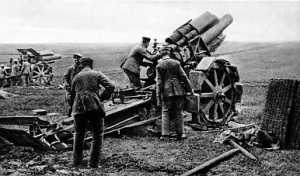
|
A heavy German mortar in front of Verdun |
The situation from the French perspective
Verdun was a garrison town surrounded by a double ring of fortresses and
fortifications situated among nearly impenetrable hills. However, the
defence of Verdun had been seriously neglected since the beginning of the
war. In 1915 the French supreme command judged the Verdun fortresses to be
useless as the heavy German artillery had just destroyed similar fortresses in
Belgium to pieces. The French fortresses were stripped from their guns and
only a few man remained. The lines of defence surrounding Verdun were
neglected as well. There had been repeated pleas for reinforcement,
especially when it became obvious that the Germans were preparing an
attack. However, the French headquarters were not interested in the pleas:
'Verdun is not an important target', was their judgement.
 Phase 2 - The German Offensive of 21 February
Phase 2 - The German Offensive of 21 February
The delayed attack
German troops were placed in position in the night of 11 to 12 February
1916, but because of the terrible weather circumstances the attack was
delayed until 21 February. This delay probably saved France from the
defeat as the two French divisions that had been hastily added to the
Verdun front-line could be placed in position and defensive improvements
could be made at the last minute.
|
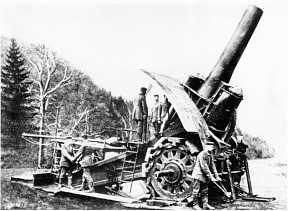
|
A Big Bertha (420 mm mortar) in front of Verdun |
The start of the German attack
The attack started on 21 February on the right bank of the Meuse with
the heaviest bombing that had ever taken place in a war. It lasted over 9 hours and was
the most horrible that man had ever seen.
In the following days the Germans did not progress as much as they had
expected, but on 25 February the unbelievable happened: the Germans occupied the most
important fortress on the defence line. This fort Douaumont had been considered
impregnable. Verdun lay within reach.
|
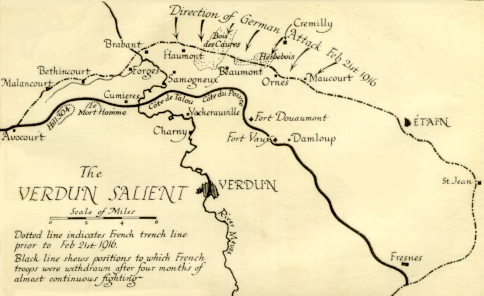
|
|
Overview map of the Verdun
salient
|
Pétain takes defence measures
The French headquarters appointed general Phillipe Pétain commander-in-chief of the
Verdun front. He immediately ordered the formation of a line of defence on the right bank
of the Meuse. This line had to be formed between the remaining fortresses which had to be
defended at any cost to buy the time needed to build fortifications.
|
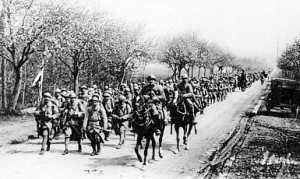
|
French troops on their way to the front-line |
Especially on the left bank more artillery was quickly set up to check
the German advance. The Germans were stopped near the village of Douaumont which is very
close to the fort. Between 26 February and 2 March the French fought over the village only
to give it away to the Germans in the end. However, general Pétain did win something: the
necessary time to fortify the French defence. It became clear to the Germans that the
attack of Verdun was coming to a halt and that the French artillery on the left bank had
to be destroyed first.
 Phase 3 - The Battle of the Flanks: the Left Bank of the Meuse
Phase 3 - The Battle of the Flanks: the Left Bank of the Meuse
The battle of Côte 304 and Le Mort-Homme
The German army command decided to attack both banks of the Meuse at the same time. The
most important aim of attack on the left bank was the Bois Bourrus. The French artillery
was concentrated here. Before this Bois could be attacked a hill called Le Mort-Homme
[Dead Man Hill] had to be taken. The attack started on 6 March 1916.
|
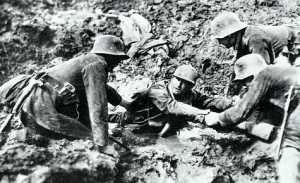
|
Germans helping a French wounded soldier |
At first the Germans advanced well, but Le Mort-Homme was fiercely
defended by the French and the Germans were more and more bothered by gun fire from a
nearby hill: the Côte 304 [Hill 304]. That is why they decided to take the Côte 304
first. The attack started on 3 May with 500 guns thundering on a field of not even a
square 2 kilometres. Under terrible circumstances and suffering horrible losses the Côte
304 and then Le Mort-Homme were taken by the Germans at the end of May. After three months
of continuous warfare the Bois Bourrus was theirs.
 Phase 4 - The Battle of the Flanks: the Right Bank of the Meuse
Phase 4 - The Battle of the Flanks: the Right Bank of the Meuse
The battle of Vaux
Two days later, 8 March 1916, the battle started on the right bank. The aim of attack was
the fortress of Vaux that had by now been fortified and could be counted among the
strongest forts of war. The German attack was immediately put to a stop by the heavy
French gunfire. The intense fights over the fort lasted until 19 March but nothing was
achieved. The German troops were exhausted and the battle was therefore deferred.
Pétain is replaced by Nivelle
By the end of April a crisis had developed in the French army command. Pétain was kicked
upstairs and replaced by general Nivelle per 1 May 1916. He was known as a merciless
basher who favoured the frontal attack. His right-hand man was general Mangin; a ruthless
front general who was known as 'the slaughterer'.
The explosion at fort Douaumont
Starting from 1 May fort Vaux was attacked; an earlier German attack had failed. There was
a lot of French resistance and when an explosion occurred on 8 May in fort
Douaumont taking the life of over
700 Germans it was decided to delay the attack and concentrate the attack on the left bank. However,
the Thiaumont fortification and fort Vaux had to be taken first.
The fall of fort Vaux
Surprisingly, before a German attack could take place the French undertook a counter
attack of fort Douaumont. Two days of bitter fights followed. The attack was warded off by
the Germans and only a few French soldiers returned to Verdun.
|
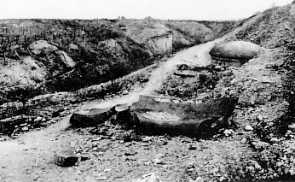
|
Fort Vaux shortly after the war |
Fort Vaux was taken on 7 July after heroic resistance by the French
major Raynal. French attempts to recapture the fort ended in pointless massacres.
 Phase 5 - The Last German Offensive
Phase 5 - The Last German Offensive
The first German attack: the occupation of Fleury
The next major German offensive was aimed at the occupation of the village of Fleury and
fort Souville. From these points the Germans intended to advance to Verdun. On 23 June
three German army corps attacked. This was the first attack in which phosgene gas was
used. 230 Guns fired a total of 110,000 of these poison gas shells.
|
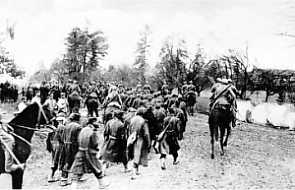
|
French prisoners of war are deported |
This did not have the anticipated result and the German attack came to a halt. The attack of fort Souville failed completely. The Thiaumont fortification and
the village of Fleury were the sole objects of occupation. The attack of Verdun had failed
again.
The Crisis of the French Defence
At the same time the French found themselves in a crisis situation. Verdun was under heavy
attack: there was even some thought of clearance of the right bank of the Meuse. In the
nick of time a German breakthrough was stopped due to the individual actions of French
officers. These officers independently organised the defence at the front and stood their
ground.
|
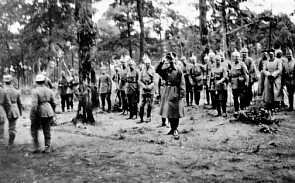
|
|
The Crown Prince takes the salute
|
The German army commander Von Knobelsdorf intended to undertake a last
attack of Verdun, but before this could take place the French mounted a counter attack,
causing the preparations of the planned attack to be postponed. There were still bitter
fights fought over Fleury under the most abominable circumstances.
The second German attack: the Failed Attack of Fort Souville
The planned German attack took place on 11 July. The French answered with violent
gunfire and soon stopped the attack. Nevertheless, the Germans did have one victory: the
village of Fleury was finally theirs. However, the German reserve troops that had
to force a breakthrough did not show and the French were able to bring fortifications at
the last moment to stop the German army. There was another attempt to take fort Souville,
but that failed as well. The German attack of Verdun had failed again.
|
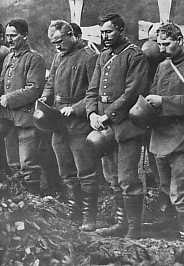
|
Funeral of a comrade |
The battle of the Somme started on 1 July 1916 and as a result of this
the activities at the Verdun front were temporarly halted. The German troops were
instructed to be
economical with munitions. More and more troops and artillery were transferred to the
Somme and the eastern front where a large Russian offensive had started. The battle at
Verdun continued unrelentingly although on a smaller scale. General Mangin started a large
offensive at Fleury on 15 July, but this attack was stopped causing numerous French
losses.
The third German attack: the Battle of Fleury
The German army command decided to attack once more, to consolidate the front between
Fleury and the Thiaumont fortification. The attack begun on 1 August and lasted on and off
until 6 September. The advantage alternated between the Germans and the
French, but neither party
achieved any real success. The fighting zone was the area between fort Souville and the
Froideterre fortification. This area had turned into a quagmire with shell
holes where both
sides took turns in attacking and counterattacking.
|
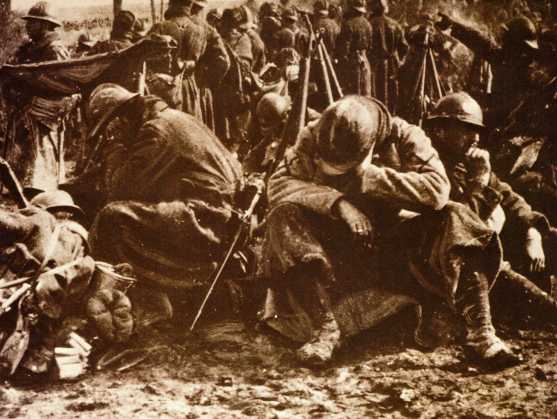
|
|
Exhausted French troops after a battle
|
The battlefield was covered with casualties; there
was no longer one front-line. The troops on both sides survived under ghastly
circumstances. There was an enormous shortage of drinking water, munitions and
food. The losses on both sides were enormous. As of 6 September rest had
(temporarily) set in at the battlefield of Verdun.
 Phase 6 – The French Offensive
Phase 6 – The French Offensive
The Relief of Von Knobelsdorf and Von Falkenhayn
On 23 August the message was received in the Stenay headquarters that general
Von Knobelsdorf had been relieved of his duties. The criticism on Von
Falkenhayn increased as well. The German Kaiser decided that Ludendorff and
Von Hindenburg should be the new commanders-in-chief, as they had proven to be
worthy of this position at the eastern front. Von Falkenhayn was posted to
Rumania. The first action of general Ludendorff was a cease fire at Verdun,
but the French army command had set their mind on striking back.
The Fall of Fort Douaumont and Fort Vaux
On 21 October 1916 the French attack on the right bank of the Meuse started
with a heavy bombardment over a part of the front-line that was seven
kilometres wide. At the same time fort Douaumont was bombed with a new sort of
400 mm gun. On 24 October the French attackers stirred: the new system of the
moving fire screen [barrage] was working excellently and the German front was
rounded up. Two direct hits found their way into the heart of fort Douaumont
and caused enormous damage. The Germans left the fort because it was
considered indefensible. Therefore it came into the hands of the French rather
easily.
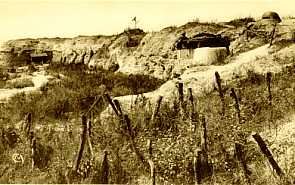
|
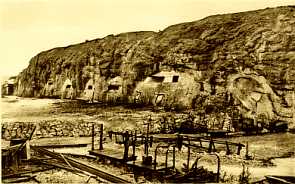
|
|
Fort Vaux shortly after the war
|
Fort Douaumont shortly after the war
|
On 25 October fort Vaux was attacked. German machine-gun fire
destroyed the trench waves of attack every time. After this the attacks of fort Vaux were ceased.
When the German army command concluded that the fort was in danger of being separated from
the German front, it was decided to clear the fort and blow it up. The French could occupy
the ruins. After this it stayed quiet on the front for a long time.
The Last French Offensive
The French decided to attack once more to force the Germans back to their original
positions of February 1916. On 11 December the French artillery fire started
again and on 13 December the French advanced behind a rolling artillery
barrage. The Germans clung on determinedly. The French
losses were huge but finally the front broke.
On 19 December 1916 the German army command concluded that they had suffered a defeat
at Verdun. The German army had once and for all been pushed back to its original
positions. The battle of Verdun had come to an end.
|












